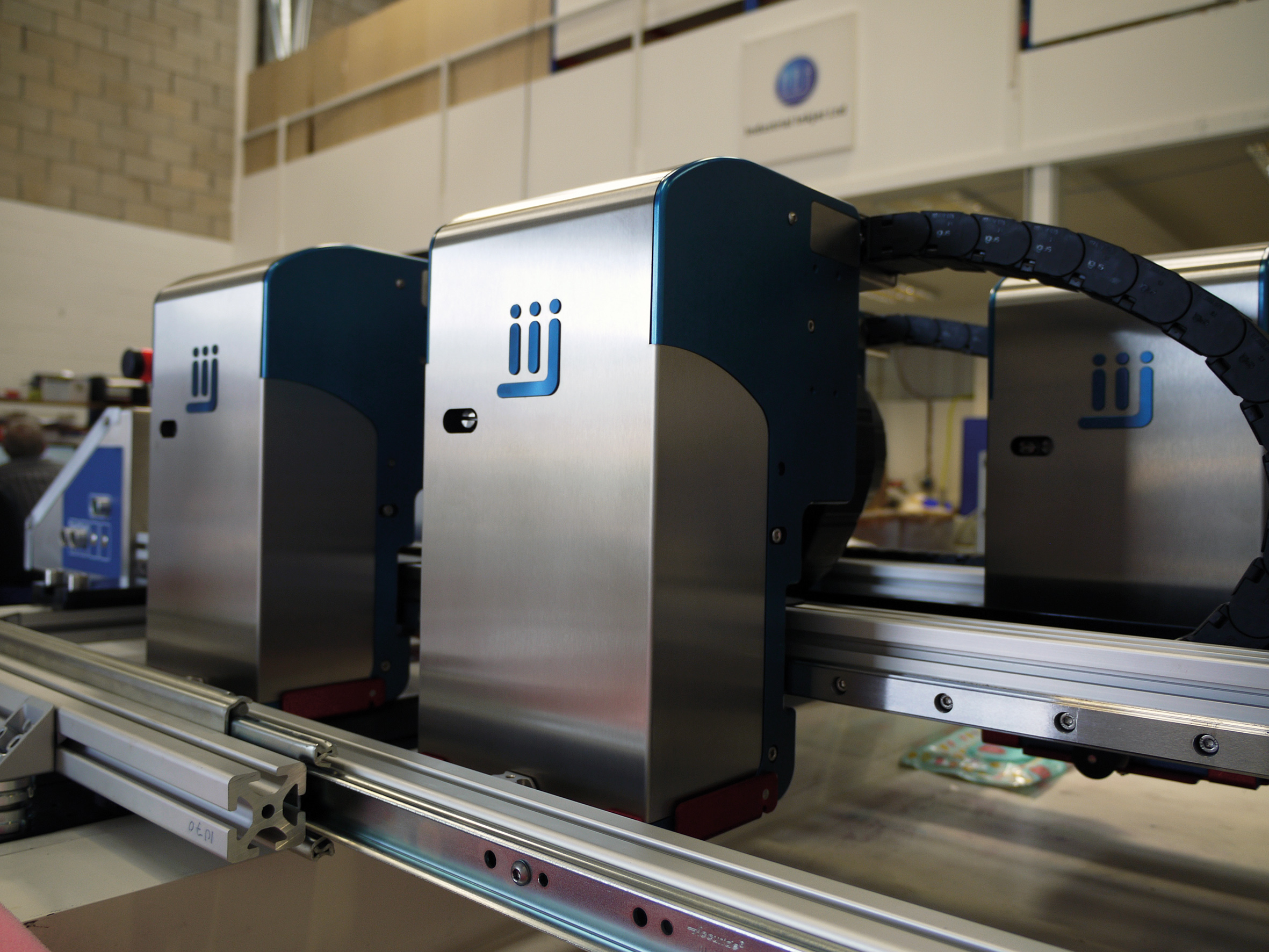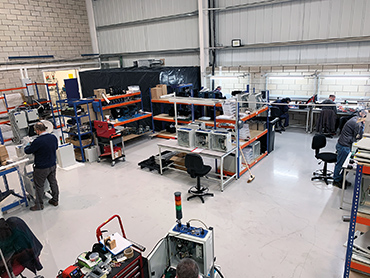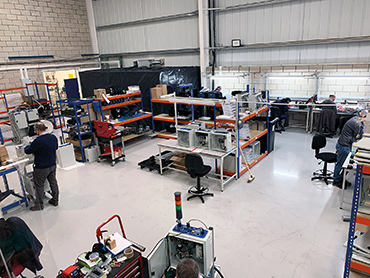At first glance you might not think that Industrial Inkjet qualifies for our Best of British series. It sells print applications for Konica Minolta’s range of inkjet printheads, made in Japan. Yet it is an all-British owned company, based near Cambridge and trading worldwide with a turnover of £8.9m in 2020.
The origins of the company, which usually goes by the initials IIJ, were rather Japanese in style though. In 2005 John Corrall was already well established in the inkjet business, having about 20 years’ experience with the UK-based companies Domino, Elmjet, Videojet, Xaar and Xennia. “I was always in an R&D or engineering role, though sometimes also service and manufacturing,” he says. “When I was at Xennia, Konica Minolta sent me their first printhead evaluation kit to try and I wrote a short review of it for them. It was only maybe one day’s work but I was apparently the only integrator to respond.”
Then he got an unusual proposal. “The idea came from Akiyoshi Ohno of Konica Minolta, who at the time was representative director and president of Konica Minolta IJ Technologies. He told me that I was to work for KM to look after tech support for their printheads in Europe. It was a ‘told’ rather than an ‘ask’! I said that I was in the process of setting up a small inkjet company already. He replied that this was fine and we could be KM’s distributor.”
The result was Industrial Inkjet Ltd, which usually goes by the initials IIJ. “The original ‘deal’ was a handshake and we ran on that basis for the first six months while we drew up an agreement,” Corrall says. “The relationship is very close, with two two-hour conference calls every week. After 15 years together there is a lot of trust in both directions, but KM has no stake in IIJ.”

Print Engines
“Originally it was set up to provide strong tech support to KM’s printhead customers in Europe,” says Corrall. “However the first customer that Ohno-san ‘gave’ me was in Cincinnati – on the basis that it was closer to me than to him. So then we were taking care of USA.
“We quickly realised that to speed up our customer’s projects we needed to supply kits of parts to build their prototype printers, so that was the first change. From 2008 we started to supply finished inkjet print engines, ie a complete inkjet unit but without the media transport system. Although we do supply complete turnkey systems, most of our business is still those original three lines.”
The single-pass inkjet Print Engines use Konica Minolta printheads and associated peripherals. They are grouped by width into small, medium and large modules, with the smallest starting at 72-75mm and the largest offering 492-594mm. All currently use either the Konica Minolta KM1024i (360dpi) or KM1800i (600dpi) printheads, with a choice of mono or colour configurations. Speeds range from 50 to 300m/minute. UV and security inks can be used, with spot varnish, high-build and white underlayer inks available for some modules.
“Our USP is really our inkjet knowledge and understanding, which means that we will tackle projects where there is no off-the-shelf solution that exists in the market,” Corrall says. “A lot of the business is retrofit, where we fit a print engine onto the customer’s existing press or production line, and so create a hybrid system. We work with a small group of ink suppliers who will create inks for new applications for us. We then create suitable hardware, modifying our standard Print Engine range to suit. We have an obsession with testing – reliability of the finished product is paramount in industrial applications.”
For the narrowest models typical applications are for numbering and coding with black or security inks, plus plastic cards, bottle caps, blister packs and small colour labels. Medium widths are often used for labels and security documents. The widest can be used for décor (eg wallpapers and laminate edges), paper documents and flexible packaging.
“We have a fun project being installed at the moment that waves a print engine around 3D sections of wooden furniture,” says Corrall. “The result is really very good, making white wood look like vintage oak. We also do a lot of direct-to-product, for example printing product info onto air trunking or abrasive sheets.”
Vital statistics
Today IIJ employs about 55 people “with several vacancies,” says Corrall, who remains managing director and owns the company together with the senior staff. Lesley Scanlon is general manager, with Mike Thwaites as global sales manager, Tony Lyons as operations manager and Graham Vlcek as president of IIJ Inc in the US.


Print engines bring in 70% of revenue, including sales of ink, spares and consumables. There are now more than 500 installed units. “Ink sales increase with the size of the installed base,” says Corrall. “Brexit has hit the ink business most because a lot of customers are on monthly scheduled deliveries. As well as customs delays there are still huge questions about duties and VAT and the relevant UK government departments freely admit that they don’t yet know the answers.”
The rest of the revenue is based on selling printheads to OEMs for Konica Minolta. “That was the original business and still does very well,” Corrall says. This was set up to cover markets outside Konica Minolta’s local south east Asia and Indian territories. However, IIJ Print Engines are sold worldwide and Corrall says there are a lot of systems in China, Thailand and Taiwan.
Growing premises
IIJ was originally set up in converted farm buildings in Knapworth, a village in the countryside near Cambridge. After outgrowing this and occupying a separate second site for a while, in 2012 it moved to an industrial estate in Swavesey, on the A14 about halfway between Cambridge and Huntingdon, which is handy for Stansted, Luton and London City airports and not too bad for Heathrow, according to Corrall.
It now occupies two adjacent industrial units with a total of 1,600sqm, with offices, production space, stores, machine testing, an ink lab, print samples area and an engineering lab. “We took on the second unit a little over a year ago and it turned out to be none too soon,” says Corrall. “It looks like sales of a new compact Print Engine will be measured in the hundreds per year and we will need all the space we have for new production lines.”
Despite the proximity to Cambridge with its pool of inkjet expertise, Corrall says that most current staff did not come from this sector. “The exception is Veena Sarojiniamma who is in charge of ink and waveform work. We worked together at Xaar in 2001. Other than Veena the team is home grown and in general this works best. When we’ve hired people from the inkjet industry in the past, admittedly mainly at engineer and technician level, there is a lot of ‘un-learning’ to do, both technically and in our way of working.”
There is also a sales and demo site in North America (in Golden, Colorado, on the outskirts of Denver), employing five and now handling some development work, plus a one-person sales and support office in South Africa.
That virus again
Inevitably Covid-19 has made an impact. “The biggest change is to our service team,” Corrall say. “We were at 86% online tech support before Covid hit, but it’s obviously now at 100%. The team have adapted really well, managing to do very complex installations via video link and TeamViewer remote control of the inkjet system.
“As for sales, the biggest change is the number of new projects hitting us. It seems that people have found time to think during the last year, and what they mainly think is that it is time to look at new technology such as inkjet. Much to my surprise we ended up having a record year in 2020 and 2021 has started off just the same.”
What’s next?
Corrall says that last year saw development of a new transfer printer for t-shirts and sportswear, working with Sakurai in Japan. This required development of a new stretchable, wash-resistant ink that meets Oeko-tex safety regulations.
“Right now we have a couple of large machines on test using a new water-based ink,” he says. “It was developed for flexible packaging and has strong colour density, so we are finding it is also suitable for printing under the silver scratch-off on lottery tickets. Water-based is definitely here to stay and we expect to see a steady change away from UV in a lot of markets.”
The biggest excitement, however, is the new compact Print Engine. This was developed for a security printing application, designed to fit inside the customer’s machine. “We have been given the nod that there is an order for 50 machines on the way – all on very tight delivery,” Corrall says. “We have had plans ready for a while to double production capacity if required, and while maintaining strict social distancing that work must now get underway without delay.”
STAR PRODUCTS
IIJ’s Print Engine is responsible for 70% of revenues. There are three main modules of different widths, with either 360dpi or 600dpi Konica Minolta printheads running at up to 300m/min. There’s a choice of ink types and single or multiple colour channels.











